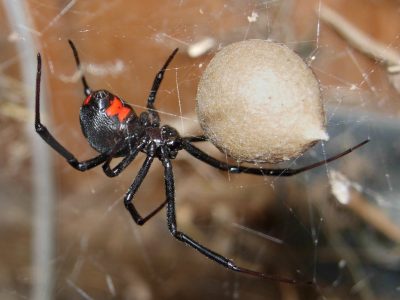Tomato Hornworm
Manduca quinquemaculata
The tomato hornworm is a ferocious pest that can eat all parts of a plant, including the fruits.
Advertisement
Tomato Hornworm Scientific Classification
- Kingdom
- Animalia
- Phylum
- Arthropoda
- Class
- Insecta
- Order
- Lepidoptera
- Family
- Sphingidae
- Genus
- Manduca
- Scientific Name
- Manduca quinquemaculata
Read our Complete Guide to Classification of Animals.
Tomato Hornworm Conservation Status
Tomato Hornworm Facts
- Name Of Young
- larvae (catarpillars)
- Group Behavior
- Infestation
- Fun Fact
- The tomato hornworm is a ferocious pest that can eat all parts of a plant, including the fruits.
- Most Distinctive Feature
- black colored horn on the last segment of the larvae's body
- Distinctive Feature
- 8 white stripes
- Wingspan
- 4-5inches
- Predators
- Birds, reptiles, wasps, betttles, spiders.
- Diet
- Carnivore
- Favorite Food
- Tomato plant
Tomato Hornworm Physical Characteristics
- Color
- Green
- Lifespan
- 3-4 weeks
- Length
- 3-4inches
- Venomous
- No
- Aggression
- Low
View all of the Tomato Hornworm images!
The tomato hornworm is a ferocious pest that can eat all parts of a plant, including the fruits.
Summary
The tomato hornworm is the caterpillar of the five-spotted hawk moth. The worm is characterized by the presence of a horn on its back which gives it a formidable look. While it does not harm humans, the tomato hornworm is a notorious pest of garden vegetables. It attacks the tomato plant and other plants in the Solanaceae family.
Tomato Hornworm Species, Types, and Scientific Name
The tomato hornworm is the caterpillar of the five-spotted hawk moth (Manduca quinquemaculata). The adult form of this worm is a giant moth in the hawk moth family (Sphingidae). There are about 1,450 species of hawk moths in up to 200 genera. The larvae of all hawk moths are called hornworms.
The five-spotted hawkmoth’s larva is referred to as the tomato horn moth. The name references the dark horn-like projection on their posterior end and the fact that they use the tomato plant as their host plant.
Appearance: How To Identify Tomato Hornworm
Gardeners often confuse the tomato hornworm with the tobacco hornworm, the larvae of the Carolina sphinx moth (Manduca sexta). Both caterpillars have a similar physical appearance and feed on plants of the same family, which makes them even more difficult to tell apart. However, both species differ slightly in their appearance.
Small tomato hornworms are typically yellow or whitish with no marking. Their color begins to turn green as they grow. At full size, the tomato hornworm is about 3 to 4 inches in length. It is one of the largest of all garden caterpillars. It is green in color and typically has eight diagonal white stripes on its sides. The tomato hornworm also has a black horn projecting from its rear. The tobacco hornworm has a horn too, but it is typically red. Also, the diagonal white stripes on this caterpillar number up to 7.
The adult form of this worm is a large moth with narrow front wings. It has a mottled gray-brown color with yellow spots on its abdomen. Their hind wings typically have alternating bands of light and dark colors. The five-spotted hawk moth has an average wingspan of about 4 to 5 inches.
Habitat: Where To Find the Tomato Hornworm
The typical range of the five-spotted hawk moth is in North America and Australia. It is found in various locations across these two continents. In the United States, five-spotted hawk moths and their larvae are more prevalent in the northern United States compared to the tobacco hornworm, which is more prominent in the south. Adult five-spotted hawk moths typically lay their eggs on the young leaves near the stem of the plants in the family Solanaceae. The tomato plant is their favorite host, but you may also find them on the eggplant, tobacco, potato, moonflowers and pepper. They feed
Diet: What Do Tomato Hornworms Eat?
The tomato hornworm feeds on various plants in the family Solanaceae, especially the tomato plant. In this larvae stage, they are voracious pests known to munch on the leaves, stems and even the immature fruit of the plant. They typically attack a plant in large numbers, defoliating it within a short time.
What Does Tomato Hornworm Eat?
The tomato plant is the host of choice for tomato hornworms. However, they may also feed on other plants in the Solanaceae family, such as eggplant, potato, pepper and tobacco. Although this is less common, tomato hornworms may also feed on weeds like the horsenettle, nightshade and jimsonweed.
As adults, they feed on nectar from flowering plants such as the Datura meteloides (prickly burr), Mirabilis multiflora (Colorado four o’clock) and Oenothera caespitosa (Tufted evening primrose). The moths are attracted to the fragrant white flowers of these plants.
What Eats Tomato Hornworm?
This caterpillar has several natural predators. Gardeners may release chickens and other birds into the garden to pick them off the plant. Similarly, some species of parasitic braconid wasps also attack the hornworms. They typically lay their eggs on the back of the hornworms. The larvae of the wasps will consume the worm when it hatches.
Prevention: How to Get Rid of Tomato Hornworm
Given the large size of these worms, an infestation is easy to detect. Getting rid of them is relatively easy as well. Perhaps the easiest and most effective method would be to pick them off the plants when you find them. You can crush the worm or toss them in a bowl of soapy water.
Gardeners often treat a bad infestation using a natural bacteria, Bacillus thuringiensis. This bacteria works by paralyzing the worm’s digestive system, stopping them from feeding. Other low-risk pesticides that are similar to this include Spinosad and Insecticidal soap. These pesticides don’t attack other insects, which makes them a better alternative to broad-spectrum pesticides like bifenthrin, lambda-cyhalothrin, cyfluthrin, and permethrin.
Alternatively, one may introduce general predatory insects like lady beetles or green lacewings into the garden. They prey on the eggs and young tomato hornworms. Some species of wasps, such as paper wasps, feed on caterpillars like this as well.
Up Next:
10 Incredible Earthworm Facts
What do Wax Worms Eat?
What is a Worm Snake?
Tomato Hornworm FAQs (Frequently Asked Questions)
Are tomato hornworms dangerous?
Despite their intimidating appearance, tomato hornworms are not harmless. Their “horn” is not sharp enough to pierce the skin, and they’re not venomous.
Is the tomato hornworm edible?
Yes, the tomato hornworm is edible and a favorite delicacy of people in some cultures. They’re cleaned, gently-friend, sauteed or roasted, after which they can be eaten. Their closely similar tobacco hornworm is edible as well.
Can tomato plants recover from hornworms?
Yes. Although hornworms eat plants at an alarming rate, your plant may still recover if the infestation is caught early and stopped. After getting rid of the caterpillar, remove the leaves of the plants. This should stimulate the production of new leaves from the existing bud
What other plants do tomato hornworms eat?
Although their favorite food is the tomato plant, tomato hornworms are known to feed on other plants in the nightshade family. This includes eggplant, pepper, potato and tobacco. They may also feed on weeds like the horsenettle, nightshade and jimsonweed.
Thank you for reading! Have some feedback for us? Contact the AZ Animals editorial team.
Sources
- Wikipedia, Available here: https://en.wikipedia.org/wiki/Manduca_quinquemaculata
- University of Minnesota Extension, Available here: https://extension.umn.edu/yard-and-garden-insects/tomato-hornworms
- Wikipedia, Available here: https://en.wikipedia.org/wiki/Sphingidae


















